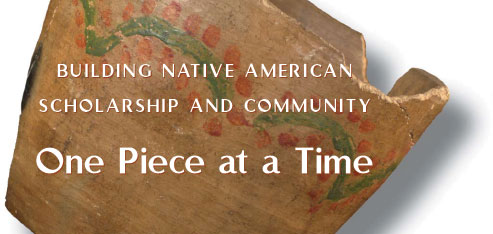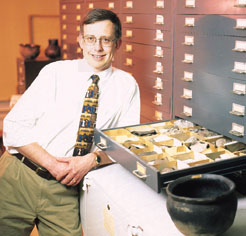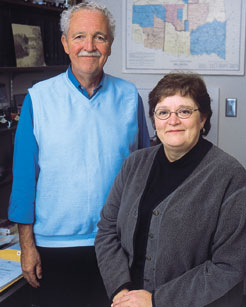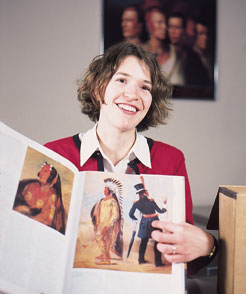

A publication of The Graduate School, University of North Carolina at Chapel Hill
On-Line Version Spring 2003
Home | Back issues | About us | Email your feedback | The Graduate School | UNC-Chapel Hill | Make a gift

When Lindsey Smith began her graduate school search, she planned on studying Anglo-Irish poetry in Boston. After an uninspiring visit to the school she’d hoped to attend, however, Smith put her plans on hold and headed home to Oklahoma to regroup. The decision would prove life-changing.
Smith began working as a tutor for elementary-age children with the Indian Education Program. Herself of Oklahoma Chickasaw ancestry, Smith helped students improve their reading skills and learn about their heritage by using Indian legends as reading material. Eventually, through her work with the children and the encouragement of an inspiring coworker, Smith began considering Native American literature as a course of graduate study.
“That year really changed everything,” Smith said. “I realized that this was something really important, something that I could teach other people.”
 |
| Photos by Will Owens |
| At UNC, graduate student Lindsey Smith found a supportive academic community to study Native American and American literature. |
 |
| Vin Steponaitis, professor of anthropology and director of the Research Labs of Archaeology, leads the Provost's Committee on Native American Issues. |
 |
| Husband and wife team Mike Green and Theda Purdue, professors of American studies and history, respectively, have led the charge to develop a curriculum for Native American studies. |
 |
| Assistant Professor Valerie Lambert brings to the classroom her experience as a social anthropologist, as a member of the Oklahoma Choctaw and as a former employee at the National Bureau of Indian Affairs. |
 |
| Sequoyah Dissertation Fellow Laura Mielke shows the kind of sentimental representations of American Indians that she is studying for her dissertation on 19th century American literature. |
Although it had no established Native American literature program, Smith chose the Department of English at UNC-Chapel Hill.
“I had a wide range of interests, and I knew UNC had an awesome English Department,” she said. “I figured I’d find a way to make it work.”
In particular, Smith wanted
to study the southeastern Indian experience. She knew North Carolina had
the largest concentration of Native Americans east of the Mississippi
River. She had also met professors Mike Green and Theda Perdue, and learned
of their efforts to bolster recruitment of Native American students and
faculty. There wasn’t a strong Native American presence on campus,
but all the building blocks were in place. The University seemed ripe
for this area of scholarship.
Creating a Curriculum
Members of the American studies and history faculty, respectively, Green and Perdue are part of the Provost’s Committee on Native American Issues first convened by former Provost Richard Richardson in 1998.
Led by Vin Steponaitis, professor of anthropology and director of the Research Labs of Archaeology, the group’s charge is to coordinate and support efforts across campus to build programs of teaching, research and service relevant to Native Americans; and to advise the provost on initiatives to increase the Native American presence on campus, with a focus on recruiting and retaining Native American students, faculty and staff.
According to Steponaitis, when the committee came together, a number of things were already happening on campus for Native Americans, but with no administrative structure, he said, “they were getting lost in the shuffle.”
Green and Perdue led an effort to build a Native American Studies Curriculum for an undergraduate minor. To complement a strong program in Native American history, the Department of Anthropology hired Valerie Lambert, a social anthropologist of Choctaw and Chickasaw ancestry and an enrolled member of the Choctaw Nation of Oklahoma. Danny Bell, program assistant for the American Studies Curriculum, was brought in to oversee the emerging program. Green, Perdue and Steponaitis also hope to add breadth to the program by recruiting a Native American literature scholar.
Although Native American studies as such doesn’t exist at the graduate level, building a critical mass of faculty will put the University in a position to offer graduate-level work and, in turn, attract students interested in the field. In history, for example, several current students working on Native American topics in various stages of their graduate program were attracted to UNC by the work of Green and Perdue.
But potential Native American faculty are not easy to come by, Lambert explained, because of a shortage of scholars in a population that is already very small. For that reason, she believes collaboration between Indians and non-Indians is essential for the field to develop.
“American Indians represent less than 1 percent of the general U.S. population, so it will always be hard to find people for these positions,” she said. “With our numbers, we need help from non-Indian people.”
For Lambert, two of Carolina’s
main attractions were the University’s strong commitment to being
a public institution and the opportunity to live and work in a state rich
in Native American culture and history.
A Fellowship Opportunity
In response to the efforts of the provost’s committee, the Graduate School earmarked one dissertation fellowship within the Society of Fellows this year for scholarship related to Native American issues, naming it the Sequoyah Dissertation Fellowship.
The recipient, Laura Mielke, is a doctoral student in English writing on the role antebellum sentimentalism played in the conceptions and depiction of race, specifically on white Americans’ notions of the Native American in early 19th century literature.
“Encountering the Indian in the Age of Sentiment, 1823-1868,” explores the era’s troubling paradox whereby popular representations of Indians emphasized their physical and emotional proximity to Euro-Americans, while the plan for removing Native Americans from eastern territories was being debated and implemented.
Mielke is studying primarily white writers, including Henry Rowe Schoolcraft, Lydia Marie Child, William Gilmore Simms, Henry David Thoreau and Margaret Fuller. Nevertheless, she remains attentive to the emerging Native American voice in print. In particular, she examines early, published autobiographies by William Apess (Pequot) and Black Hawk (Sauk) and their subversive use of sentimental rhetoric.
“It’s hard to understand the relationship between culture and politics in a period where one portion of the population is silenced,” she said.
According to Mielke, the portrayals
she is studying contain moments of both cross-racial intimacy and overwhelming
violence. They suggest a dramatization of the process by which a nation
comes not only to rationalize, but also accept emotionally its exclusion
of indigenous minorities.
Serving the State’s Native Culture
Understanding the history of her tribe is a major motivating factor for one graduate student doing research on Indian culture in North Carolina.
After working as a documentary filmmaker for five years, Malinda Maynor came to UNC to study history and to be closer to home. A member of the Lumbee tribe and a Durham native, Maynor earned a master’s degree in documentary filmmaking from Stanford University and produced three films that explored Native American cultural identity. The last of these was a full-length feature about Native American sacred sites and religious freedom that premiered on PBS.
Despite this success, Maynor felt something was missing.
“Film is a great medium to communicate in, but it has to be conflict driven,” she said. “I realized I wanted to move home and understand more of the history. I wanted to get more involved in my own tribal history and how that relates to what people are going through today.”
A Caroline H. and Thomas S. Royster Jr. Fellow, Maynor completed a master’s thesis last year on the Lumbee Indians’ role in the turpentine industry. Her current research deals with the internal politics within the Lumbee tribe between the 1920s and 1950s and its effect on the tribe’s developing relationship with the federal government during that time.
Along with her research, Maynor is also active in the preservation of her tribe’s heritage as coordinator of a Lumbee River Fund project to create an archive of Lumbee history at UNC-Pembroke.
She said, “For many native
people, it’s your history that defines you.”
Fostering Community
 |
| Photo by Will Owens |
| Royster Fellow Malinda Maynor has focused her studies on the history of her own people, the Lumbee tribe of North Carolina. |
 |
| Photos courtesy of Michelle Schohn |
| Graduate student Michelle Schohn, top left, is part of a team of UNC archaeologists surveying a site in a Catawba reservation near Turkeyhead, S.C. |
Although little has been written about Lumbee history, for Maynor, finding academic support for her interests was easy given Perdue’s extensive work on southeastern Indians. Smith, on the other hand, met with a few more roadblocks.
The English Department’s offerings on Native literature were limited when she arrived and remain so. While UNC has scholars with expertise on the subject as well as faculty eager to see it develop — including Senior Vice President for Academic Affairs Gretchen Bataille and Boshamer Professor Emeritus Townsend Ludington — Smith had to do a lot of footwork early on to seek them out. This challenge, coupled with the death of her Native American mentor in Oklahoma, made Smith’s first year at Carolina a difficult one.
“What got me through it was the support of other Native Americans in the Graduate School,” she said.
Her perseverance eventually paid off. Smith completed a master’s thesis on Native American characters in William Faulkner’s short stories. Smith had a personal connection with the subject, she explained, because her father’s ancestors in the Chickasaw tribe lived in the Mississippi Faulkner wrote about before they were removed to Oklahoma. Doing that research, she noticed a connection between the Indians and African-Americans in the stories. She is now pursuing research that focuses on the relationship between these two groups in contemporary works.
Last fall, the English Department approved a minor in Native American literature for Smith to complement her study of 20th century American literature.
Recognizing the need to channel institutional support for Indian students into one centralized effort, this spring the Graduate School created a new assistantship that will function as the main contact for information for current and prospective graduate students. The new position plugs students into sources for academic and financial support, and helps foster a nurturing community where students won't feel isolated.
Michelle Schohn, a graduate student in anthropology and a member of the South Carolina Pee Dee, said that when most American Indians go to school, they are leaving behind a close-knit community, and one in which they are part of an ethnic majority. As the first Graduate School assistant for Native Americans, she is focusing her efforts on recruitment as well as retention. Smith will take up the post this fall.
In her academic work, through a specialization in archaeology, Schohn is literally digging up lost Indian history. The University's program in the archaeology of the American South, which Schohn considers the best in the country, is another place in which study of Native American culture has thrived. In the Carolinas, Schohn said, "there may have been as many as 200 or more different tribes, quite a few of which are still around."
Her work on South Carolina's Catawba Indians between 1700 and 1760 focuses on the development of the tribe's ethnicity through influence of other ethnic groups absorbed into the tribe. Schohn has also conducted field research on American Indians from South Carolina and Mississippi, 1000 to 1660.
She counts her assistantship with the Graduate School along with her archaeological work as contributions to her Indian heritage.
"I can give back some
of the knowledge that's been lost, and I can be a role model and support
mechanism for students who come to the school," Schohn said.
Potential for the Future
Once she graduates, Smith hopes to find a teaching job near her family, where she can work with Indian communities.
Her bet on Native American studies at Carolina paid off. The University's programs for Native Americans and for Native American studies have grown considerably since her arrival. Nevertheless, much remains to be done and to be learned.
Native Americans remain a minority
among minorities on campus. Maynor said, "Historically, we've been
one of the two groups and there's been so many more African-Americans.
It's hard to make that
separate experience felt. Having [Native American] students on campus
really enhances the educational experience for everybody."
Also, the diversity within Native American culture has yet to be tapped into.
"One of the things I stress in my classes is diversity," Lambert said. "Now, we're just trying to get a foot in the door. It would be great to have diversity of American Indians expressed in the faculty; that would be the ideal."
But Lambert remains optimistic
about Carolina's future, concluding, "There's a lot of potential
here."
- Alexandra Obregon
© 2003, The Graduate School, The University of
North Carolina at Chapel Hill
All text and images are property of The Graduate School
at the University of North Carolina-Chapel Hill. Contact Sandra Hoeflich
at shoeflic@email.unc.edu
to request permission for reproduction.
Contact Deborah Makemson at makemson@email.unc.edu if you have technical problems with this Web site.